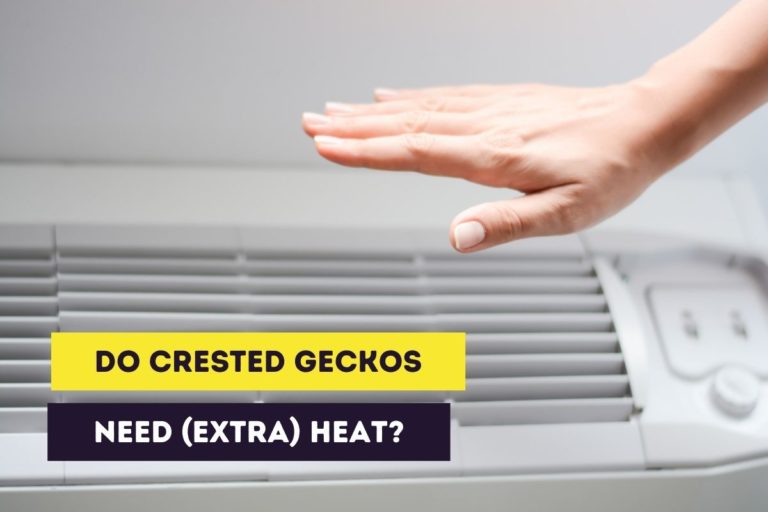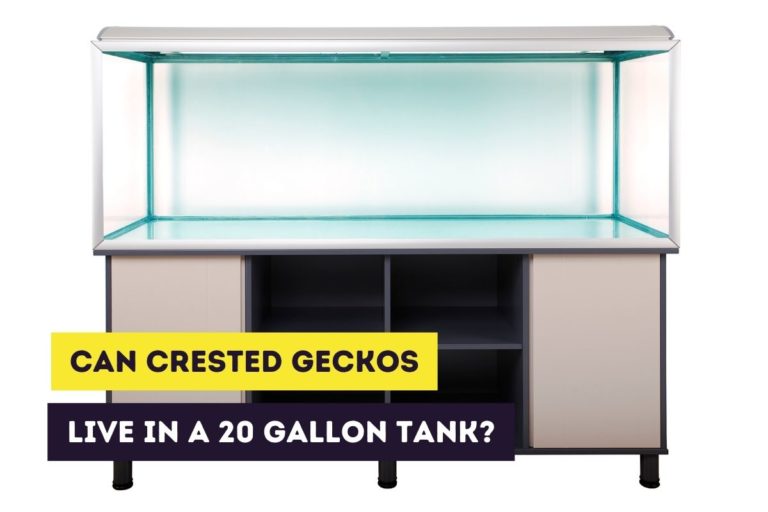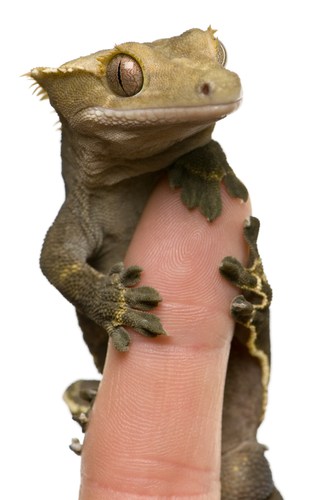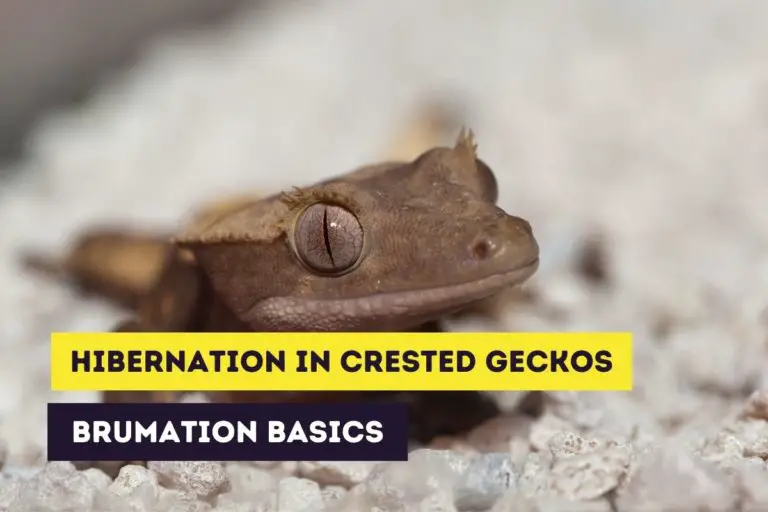How to Regulate the Temperature in a Terrarium
If you know a bit about reptiles you already know that reptiles are cold-blooded and that they depend on the surrounding temperature to stay warm and active. Temperature is important for any reptile, including the crested gecko. So what temperature does your crested gecko need?
Crested geckos need a temperature that ranges from 72 to 78 °F during the day. At night the temperature can be between 69 and 74 °F. A thermal gradient in the enclosure will benefit your crested gecko. Don’t expose your crested gecko to low or high temperatures, which can cause health problems.
Crested geckos are reptiles but are quite easy and don’t need a high temperature to thrive. In fact, most crested geckos are kept in terrariums without any heating equipment. Still, it’s important to know a little bit about the best temperature for your crestie.
In this article, you’ll learn what the ideal temperature is for a crested gecko and how to create the perfect thermal environment. You’ll learn what heating supplies are available and how to monitor the temperature in the enclosure.
If you’re interested in stickers or other products of crested geckos, you can always visit our Etsy Shop, which is called Artful Animalia. We currently only send stickers in the United States. If you’re interested in certain crested gecko-related products, don’t hesitate to contact us.
This site contains affiliate links to products we recommend and use ourselves. We may receive a commission for purchases that you make through these links. If you’re interested in learning more about our affiliate links, please visit our (affiliate) disclaimer.
Why Do Reptiles Need Heat?
Reptiles rely on the surrounding temperature to regulate their warmth. To raise their body temperature a reptile will bask in the sunlight. To lower the temperature they’ll find a hiding place under a rock or plants.
The temperature is an important aspect for reptile owners because it influences the sleeping habits, the breeding process, and the food digestion.
Do Crested Geckos Need Heat?
The Ideal Temperature
The ideal temperature for crested geckos ranges from 72 to 78 degrees Fahrenheit (22 to 25.5 degrees Celsius) during the day. During the night they can handle lower temperatures. At night the temperature should range between 69 and 74 degrees Fahrenheit (20.5 and 23.5 degrees Celsius).
So, crested geckos don’t really need high temperatures. If you look at these temperatures you will see that these are roughly the same temperatures that humans like. Most room temperatures will be fine for a crested gecko. So if you live in a mild climate and the room temperature is between these temperatures you should be fine.
What If It Gets Too Hot?
If you live in a hot region or if it’s a really hot summer you’ll need to move the terrarium into a cooler room. Crested geckos can have stress from the heat and can even get a heat stroke if the temperature reaches temperatures above 85 degrees Fahrenheit (29.5 degrees Celsius).
Cresties can easily get overheated when it’s too hot. When the terrarium is next to a window the hot sun that shines through the window may raise the temperature in the terrarium really fast. It’s for that reason that I wouldn’t recommend placing the terrarium next to a window.
What If It Gets Too Cold?
During the winter cresties will tolerate night-time temperature drops as low as about 65 degrees Fahrenheit (18 degrees Celsius). They can even tolerate temperatures as low as 50 degrees Fahrenheit (10 degrees Celsius) if they are able to warm up later.
However, if the temperature is consistently lower than 72 degrees Fahrenheit (22 degrees Celsius) you may need to provide additional heating. In most cases, a low-wattage incandescent bulb will provide enough warmth for your crestie, and enough light for the live plants in the terrarium.
Creating the Perfect Thermal Environment
In the wild crested geckos will move during the day and night from one area to another. These different areas have different temperatures. So if the crested gecko needs to raise its temperature it will move to a hotter area and when it needs to cool down it will move to a cooler area.
Off course you won’t have the same space as the crested gecko has in the wild. So how can you create such “microhabitats” in your terrarium? One answer, thermal gradients.
How to create a thermal gradient
Put a heating device on one end of the enclosure
Putting a heating device on one end of the terrarium will create a so-called basking spot, an area where the temperature is the highest. If the crestie needs to increase its body temperature it can move to this basking spot. Crested geckos are arboreal and it’s best to create a basking spot high in the terrarium
Put in branches and vegetation around the enclosure
The temperature will drop as you go farther away from the basking spot. To create shades you’ll need to put in branches and plants in the terrarium. The plants and branches will create perfect hiding places and the shadow areas they create will have a lower temperature.
Measure the temperature of the basking spot
The basking spot should be between 80 and 83 degrees Fahrenheit (27 to 28 degrees Celsius). If the crestie is still young create a basking spot that is 80 degrees Fahrenheit tops.
Measure the temperature at the other side of the enclosure
You don’t want the temperature on the other side of the terrarium to be too cold. Measure the temperature on the opposite side of the basking spot. It should be around 70 degrees Fahrenheit (21 degrees Celsius).
Heating Equipment
If you need to increase the temperature in your crested gecko terrarium, you can choose between a lot of different options. At first, it can seem a bit overwhelming. That’s why I’ll guide you through the different products that are out there with a list of their benefits and disadvantages.
Important: when you’re dealing with heat you’ll always have a certain kind of fire risk. When you buy heating equipment it’s important to research the fire risk that it poses.
Heat Lamps
Heat lamps are probably your number one choice for heating the terrarium. A heat lamp has two parts: an incandescent lightbulb and a metal reflector dome. There are lightbulbs of different wattage available.
How does a heat lamp work?
The bulb produces heat and light while the dome concentrates the heat on one area in the terrarium. The higher the wattage, the higher the temperature.
Pros & Cons
| Pro | Con |
| Easy to use | Still a fire risk |
| Easy to change temperature | Can cost a lot of energy |
| Low fire risk | Can’t be used day and night |
Important!
I recommend that you pick a heat lamp with a ceramic base rather than a plastic one. This way you can reduce the fire risk. You don’t have to worry a lot about the price difference. Fire safety is a lot more important.
Heat Emitters
Heat emitters create a lot of heat and no visible light. They typically consist of a ceramic element that’s fine to use in high-humidity enclosures.
How does a heat emitter work?
The heat emitter produces infrared heat with a long wavelength. The infrared heat warms the crested gecko and raises the ambient temperature in the terrarium.
Pros & Cons
| Pro | Con |
| Longer lasting than light bulbs | More expensive than light bulbs |
| Can be used day and night | Difficult to see if emitter is hot or cold |
| Can be used with a thermostat | Can get extremely hot |
Heat Panels
A heat panel is a bit like a heat pad that you put on the roof of the terrarium. They usually have a plastic or metal casing with internal reflectors to reflect the infrared heat in the terrarium. Radiant heat panels (RHP) are one of the more popular heating equipment for birds and reptiles.
How does a heat panel work?
Heat panels work like heat emitters and send in infrared heat with a long wavelength in the terrarium. But unlike heat emitters, they maintain a nice temperature and won’t get too hot.
Pros and Cons
| Pro | Con |
| Easy to install | Expensive |
| Works with thermostats | |
| Can be used day and night |
Heat Pads
Heat pads are put on the bottom of a glass terrarium. It can’t be used with a plastic terrarium because it will melt the plastic.
How do heat pads work?
Heat pads work just as heat emitters and heat panels. They create infrared heat with a long wavelength. Heat pads are put on the bottom of a terrarium and will emit the heat from the bottom up.
Pros and Cons
| Pro | Con |
| Inexpensive | High risk of contact burns |
| Easy to install | High fire risk |
| Can be safe(r) when used with thermostat | Can damage the surface on which it’s placed |
Heat Tape and Heat Cables
There is a great similarity of heat tape and heat cables to heat pads. Heat pads are often pieces of heat tape that are connected to each other. Heat tape is used to heat a large number of terrariums and will often require electrical connections and a thermostat. There are heat tapes and heat cables available for reptiles but there aren’t a lot of commercial brands so it’s not that easy for a newbie.
Heat Rocks
Heat rocks are rock-shaped equipment that produces heat from within. A heat rock will produce a lot more heat than a heat pad but they used to cause burns when reptiles came in contact with the rocks. There are heat rocks that can be safely used nowadays with a thermostat.
Best Heating Equipment for Crested Geckos
First of all, you probably don’t even need to place heating equipment in the terrarium. But if you do decide to create a thermal gradient in the terrarium you’re better of with either a heat emitter or radiant heat panel.
There are also people that recommend heating pads or heating rocks. I don’t recommend them because they aren’t suitable for an arboreal species like the crested gecko. Heating pads will heat from the bottom and won’t raise the ambient temperature enough. Heating rocks can cause burns because of the thin skin of cresties.
Monitoring the Temperature
You will need to know the ambient and surface temperature of the terrarium. Ambient temperature is the air temperature while the surface temperature is the temperature of objects in the terrarium.
A good crested gecko owner monitors both because they can be very different. To measure the ambient temperature you should use a probe thermometer. This kind of thermometer can take temperature readings at different parts of the terrarium. To measure the surface temperature you can use a temperature ‘gun’ thermometer. This kind of thermometer is great for reading the surface temperature of the plans and the substrate.
In a lot of pet stores, you can also find ribbon thermometers. These are cheap alternatives for a real thermometer but aren’t that reliable. For this reason, I wouldn’t recommend using this kind of thermometer.
Related Questions
Can I just put the terrarium near a heat source in the room? If you got a stove or another form of local heating in the room where the terrarium is located, you can put the terrarium near this heat source. This is especially useful if you live in a colder climate or in the winter. Make sure the terrarium doesn’t come in direct contact with the heat source and make sure it doesn’t get too hot.
Can I still use air-conditioning? Of course you can still use air-conditioning. But if you use this all the time you’ll probably need to use one of the heating equipments mentioned above to create the right thermal environment for your crested gecko.
Want to Learn More?
If you want to learn more about crested geckos as pets, please read the following articles.
If you’re interested in getting crested geckos as pets you should also definitely read our article about baby and juvenile crested gecko care or (adult) crested gecko care.







